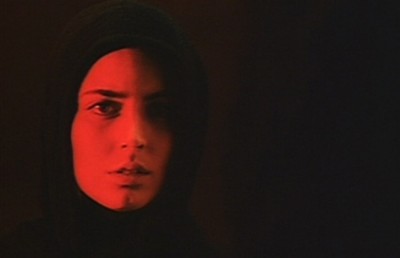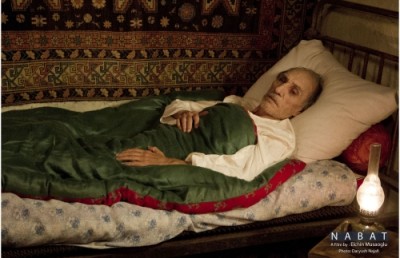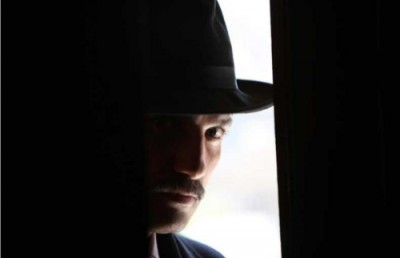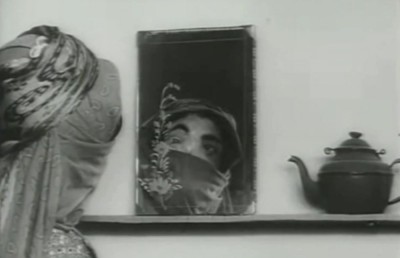Certified Copy, or “Mirroring Life, Mirroring Art”
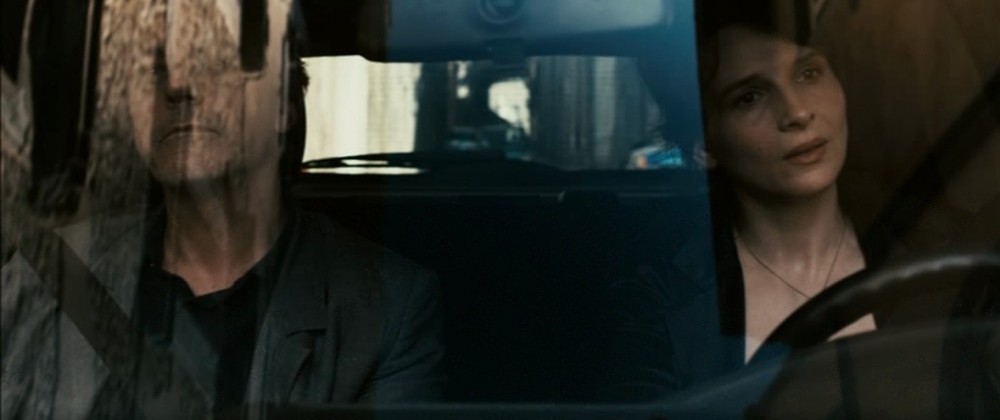
Iranian cinema is strongly identified for its nuanced and in some cases highly innovative style of reflexivity that casts a long shadow over clear demarcations between art and reality, fiction and documentary, realism and stylization. In an earlier essay on reflexivity in the films of Mohsen Mahkmalbaf, 1 I noted how Iranian cinema uses many of the standard modes of reflexivity, like intertextuality, anti-illusionism and self-referentiality; but alongside these more common modes of reflexivity Iranian cinema has added many new wrinkles: 1) a particular way of blending reality and fiction through the use of professional actors and social actors 2) the use of a central metaphor, which functions like a Persian version of Plato’s Allegory of the Cave, of the mirror and the copy 2 and 3) the use of narrative surprises that dramatically shift the plot, narrative or tone of the piece to make the audience question the ontology of what they are watching.
I would like to draw this latter third device out with an analysis of Abbas Kiarostami’s Certified Copy, which deals with a relationship between British writer named James Miller (played by William Shimell), in Italy to promote his latest non-fiction art history book Certified Copy, and a French art gallery owner named, “Elle” (played by Juliette Binoche). Elle, accompanied by her ten year-old son, introduces herself to James during the book signing and invites the writer to visit her art gallery. James accepts, as well as her offer to spend the day travelling the Tuscan city and countryside discussing, among many subjects, questions about truth and authenticity in art and, the subject of his book Certified Copy, whether there is a genuine difference between an original and a copy, if there are no discernible differences between them? The latter question turns inward, like a snake swallowing its tail, when at about the half way point in the film Kiarostami asks whether it makes a difference, to us as viewers, if these two characters, James and Elle, are really a married couple, or whether they are simply acting as if they are a married couple? Indeed, is there any difference between actors acting as husband and wife, say Juliette Binoche and William Shimell, and characters, say Elle and James, acting as husband and wife? Without a discernible reason, this is what Kiarostami’s narrative does to the viewer: it morphs two people who we thought were strangers, talking about marriage and parenthood and children and responsibility, into a married couple talking about the same subjects.
This change of character from strangers to long-time partners is the reflexive turn that marks the film, and one that thoroughly surprised and intrigued me; but the more I watched the film I began to pick up on another (if more common) reflexive aspect: how the film, in an almost scene by scene fashion, is an homage, or perhaps more fittingly, a “copy” of some of the greatest ‘romance’ films in cinematic history; and by romance I do not necessarily mean conventional Hollywood romance, but also great art house films that feature couples, married or not, experiencing love and intimacy but filtered through emotional or psychological trauma; many of these referenced films are modernist classics marking milestone moments in the representation of post-war social and psychological malaise and suffering, through nervous breakdown, alienation from urban life or disturbed memory.
What follows is a ‘close sequential viewing” of the film which will point out some of these cinema historical “mirrorings” either performed by Kiarostami or by my own critical and interpretive fancy (hence I do not claim that every one of these allusion are by design). As is the case with most forms of film criticism, the writing reveals as much about the writer as the film. For starters, the decision to shoot the film in Italy has important historical ramifications, with Italy being home of the first major post-war film movement, neo-realism, which had and still has an enormous influence on New Iranian Cinema. Not only for the renewed realism but for the important role given to children in neo-realism, which was carried over in New Iranian Cinema (Children of Paradise, The Runner, The White Balloon, The Apple, etc.). On the other end, Italy was one of the main hotspots for the post neo-realism modernism and art cinema that flowered throughout the 1950s and 1960s across Europe.
Several critics have already noted the relationship this film holds to Kiarostami’s own 1977 film The Report which features a married couple in a failing marriage; in terms of other European art films, critics have also noted the influence of Rossellini’s Voyage to Italy (1954), which concerns a ‘mixed’ married couple (Anglophone George Saunders and European Ingrid Bergman) who visit Naples and its surrounding areas with the feint hope of saving their marriage. Something about their respective encounters with the environment –what exactly is never stated– seems to affect them both, to the point where their marriage, quite surprisingly and perhaps magically, seems on the verge of reconciliation. Such a fate remains even more open-ended in Certified Copy, but remains a possibility nonetheless.
The opening scenes introduce James in his milieu reading from his book Certified Copy to an interested audience, which include Elle and her 10 year old son; followed by a scene at a café between Elle and her precocious, technology-absorbed son. The first ‘romantic art house allusion’ to be made is the scene about 15 minutes in where James visits Elle’s art gallery and they begin their relationship. The scene made me think of the scene in Antonioni’s Red Desert (1964) where the Richard Harris character Corrado visits Giuliana’s (Monica Vitti) as yet unopened business. Although not an art gallery, Giuliana’s inclinations are art directed (she hesitates over which color to paint the store’s walls) and the feel of both spaces, dark, with heavy wall materials, are similar. Elle’s slightly flustered, nervous behavior contrasted to the man’s more relaxed behaviour recalls the first meeting between couples in another romantic classic, Alvy Singer and Annie Hall (Woody Allen and Diane Keaton) Annie Hall (1977). And like in Annie Hall, when they decide (for different reasons) to leave for a drive, it is the woman who owns the car and who drives. The car ride itself, with the camera attached to the front of the car tracking back in a four minute long take, framing them in a two shot through the front windshield, is a purely Kiarostami stylisitc gesture.
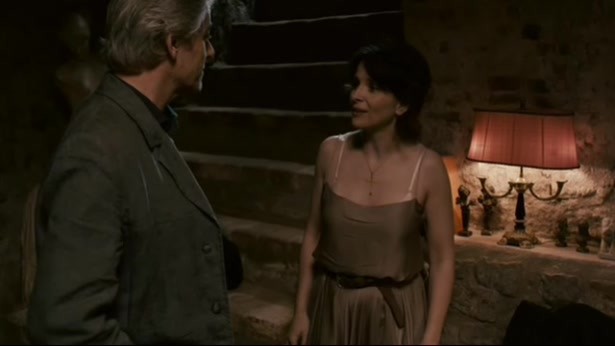
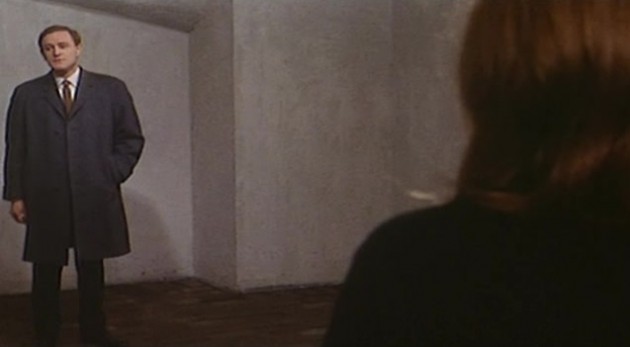
Red Desert
Elle drives James to see a painting that is famous as an “original copy”, a “real copy” that was thought to be the original up until it was revealed to be a copy by a local artist fifty years ago. The scene of them looking together at the same painting in a museum recalls the opening scene of Nicolas Roeg’s bruising ‘romancer’, Bad Timing (1980).
The film’s key moment in terms of the narrative surprise/twist and formal mirroring takes place at forty minutes in a scene at a café, where they stop for a pause and begin to talk in a more intimate and confrontational way; a tone not normally adopted by strangers but by lovers, or married people. The conversation is handled in disarming full frontal close-ups, with the camera assuming the position of the other character. James begins to tells her a story that dates back five years to a time when he was in Florence for a conference and he saw a woman with her son that intrigued him. Elle’s quiet but concerned reactions suggest that she is being upset or emotionally touched by the story, as if it were her he was talking about. She even replies, “Sounds quite familiar,” as tears run down her face. He describes the odd way that the woman and son walked, with the boy always fifty paces behind the mother, and never caring to catch up. This odd description recalls, at least to me, the older British couple in Jacques Tati’s Les Vancances du M. Hulot, who are always walking at a distance from each other. When James asks if she knew them, she replies, again cryptically, “I wasn’t well in those days,” perhaps an allusion to the neurotic Giuliana from The Red Desert. Toward the end of his story he invites her to comment on an event as if she was no longer a passive listener of this past event, but a participant, “The mother had not told the boy, am I right?” At this point his cell phone rings, and he leaves the café to answer the call, and then a very odd thing occurs. Elle engages in talk, switching to perfect Italian, with the café’s owner, a woman in her late 50s, early 60s. The lady refers to James as Elle’s husband, and Elle does nothing to correct her. They begin to talk about marriage and gender dynamics, work and fidelity, in marriage. As audience members we ask, is Elle just playing along with the lady, keeping up appearances, or is she really beginning to think she is married to James? Or, a third option, has this moment convinced Elle to drop her façade and be who she really is, James’ wife? At this moment, about 49’20” in, a subtle but meaningful gesture occurs: the elderly lady steps in front of the seated Elle, blocking her from the camera’s view, bends over and whispers something into her ear. As she leaves the frame screen left we see Elle shaking her head and laughing, with James framed in the background outside on the phone. What did the lady whisper into her ear? Could this moment be Kiarostami’s manner of ‘hiding’ the truth from us? From this moment on when Elle speaks to the lady about James she refers to him as her husband, with no ambiguity suggested or implied. He IS her husband. When James returns into the café Elle relays the identity error made by the lady. James looks at her and says, “Really….obviously we make a good couple.”
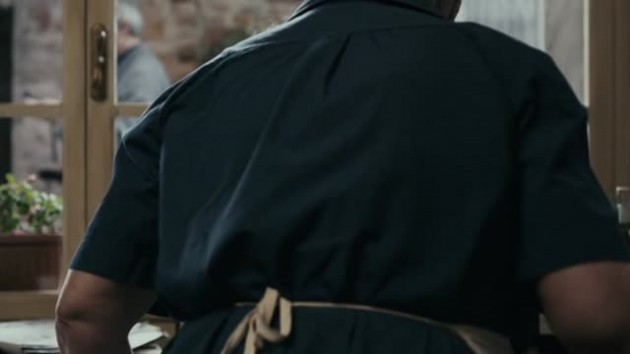
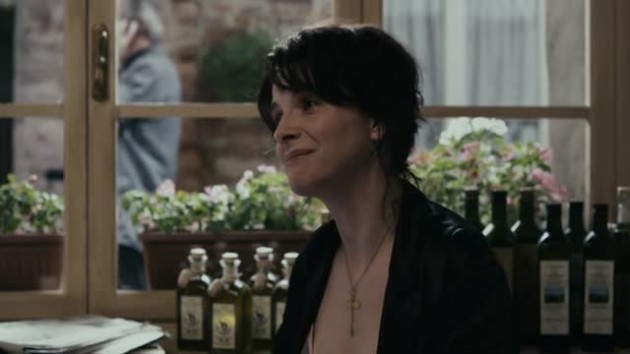
The question of whether they are indeed strangers acting like a married couple, or a married couple also recalls Wong Kar Wai’s romance masterpiece In the Mood for Love (2000), which relates the story of a couple, Mrs. Chan (Maggie Cheung) and Chow Mo-wan (Tony Leung) who discover that their respective partners are having an affair with each other, at which point they begin to see each other and take comfort in each other’s misery and perhaps fall in love. In one famous scene Mrs. Chan seems to be confronting her husband about his affair, but a cut reveals that she is in fact rehearsing the potential confrontation with Chow, who is playing the role of her unfaithful husband.
Following the restaurant scene James and Elle walk down a narrow street and begin to speak in French, before slipping back to English, with Elle complaining how he has “never been there” for her and her son. After this minor argument they walk into a church to witness the marriage of a young couple. The device of a troubled marriage being contrasted to another young couple about to embark on their marriage journey recalls Sunrise (F.W. Murnau, 1927), and the scene where the wife and husband come across a young married couple exiting the church moments after the wife realizes that her husband had contemplated murdering her.
The couple walk into a city square, peopled by tourists and other newlywed couples. In the square James and Elle get into an interpretive argument over the meaning of a statue of a man and a woman, disagreeing on what the gesture of the woman’s hand on the man’s shoulder means. This scene is a direct reference to a similar argument over a sculpture by the Man and the Woman (or A and X) in the Last Year at Marienbad (Alain Resnais, 1963). Elle leaves James in search for someone to corroborate her interpretation. The shot cuts to a long shot of what looks like a man with his back to the camera, arguing with a woman; our interpretation of this moment changes when he shifts and we realize he is talking on the phone, and not arguing with the woman he is with (a cinematic sleight of hand that recalls the above mentioned scene from In the Mood for Love, where the camera’s position behind the seated man disguises the true meaning of the scene). Elle approaches this couple and asks them their thoughts on the statue. This couple in fact is played by the French writer/actor/director Jean-Claude Carrière and actress Agathe Natanson, who herself is married to actor Jean-Pierre Marielle in real life. This gesture of an actress who happens to be married to a real actor playing an actress married to another ‘actor’ who happens to be acting as her husband is yet another pretzel logic bit of reflexivity Iranian style. We see Elle smile and motion for James to come join them, which suggests to us that the strangers have complied with her reading of the statue. Elle excitedly asks the woman several times to repeat what she said to her a few moments ago to James. This form of near manic wish fulfillment where a stranger with some authority, in this case film actors, validates your ‘layman’s’ opinion against an ‘expert’s (James is an art historian) can be seen as another allusion to Annie Hall and the famous scene where Alvy Singer calls upon Marshall McLuhan to validate his belief that a university professor in the ticket line behind him pontificating on Marshall McLuhan knows “nothing about Marshall McLuhan.” (69) The two couples break up for a short walk, with the two men walking in front and the two women a few short passes behind them. The older man gives James some friendly advice on how to resolve a marital disagreement with a simple gesture, the placement of his hand on her shoulder (life imitating art, the statue). The couples stop, greet each other and go off on their separate way, with James and Elle maintaining their marital ‘illusion’. With this apparently minor scene Kiarostami weaves a complex interplay between authentic and false, realism and art, fiction and documentary.
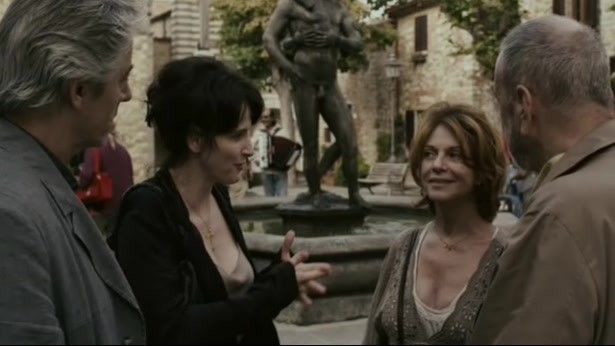
Acting Married
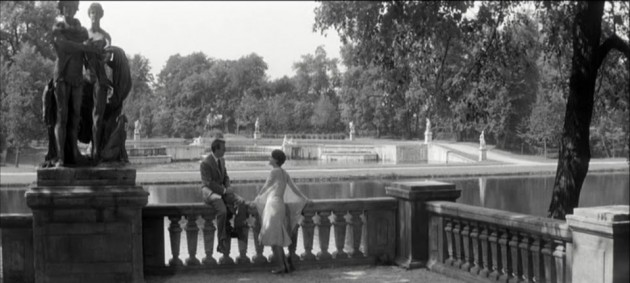
Last Year at Marienbad
They step into a restaurant and now act as a couple who have been married for 15 years. Elle becomes angry because James forgot about their anniversary the night before, and that he “fell asleep” in bed. He replies that she should not expect them to have the same passion for each other after 15 years as the newlywed couple outside the restaurant. The dialogue here is purposely scripted to feel like a cliché from a stuttering marriage, or bad romantic film. They argue, he storms out of the restaurant, soon followed by Elle, who enters a nearby pharmacy and is seen taking medication with a drink of water. This scenes seems an homage to Orson Welles’ 1942 The Magnificent Ambersons and the scene where Lucy feigns not caring for her suitor George to make their separation easier on him, and then after they part ways she enters into a pharmacy and feints while waiting for the clerk to bring her a sedative.
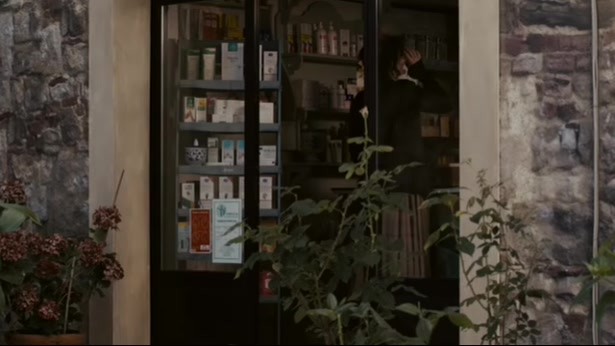
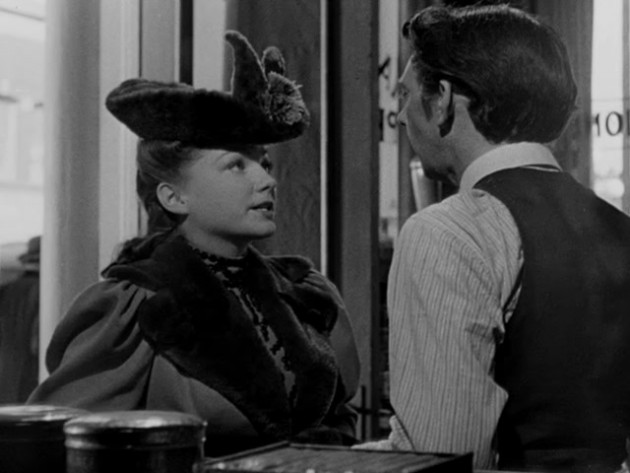
The Magnificent Ambersons
In the final scene James and Elle seem to be consoled by the sight of an elderly married couple exiting a church and slowly walking away together. They stop to sit on the steps of a pensione. James expresses surprise at having seen Elle praying in the church. The pensione they are sitting at ends up being the one they spent their honeymoon night in 15 years ago. Elle enters the pensione, tells the clerk that they spent their honeymoon in room nine and asks if they can see the room to relive some memories. This plot point seemed familiar to me, but when I tried to recall which film I might have seen this I was drawing a blank…..until I re-watched the 2011 Ti West horror film, The Innkeepers and such a scene occurs near the end, with an old man returning to his honeymoon site, as the place to commit suicide. 3
James and Elle enter hotel room #9, where Elle recalls every detail of the night 15 years ago, while James either doesn’t recall, or chooses not to. In any case something has softened in their behaviour toward each other. While Elle tries to fulfill her romantic illusion and pleads with James to remain the night, James, the realist, replies that, as he said at the start of their day, he has a train to catch. To which Elle replies, “Yes I know….James, James, James.” If this moment is taken at face value, then we can deduce that they have both been play acting as a married couple. But with Kiarostami things can rarely be taken at face value. James leaves the bedroom for the bathroom, where he stands and stares into the mirror/camera. Kiarostami leaves us with this enigmatic final shot, which recalls, no literally ‘mirrors’ in a double entendre manner, an earlier shot from the restaurant argument scene (about 25 minutes earlier than this point) where Elle excuses herself to visit the bathroom, and we get a shot of Elle staring into the mirror/camera applying makeup and earrings (a reference to the great Max Ophuls film, The Earrings of Madame de….???). Both shots are given an additional hue of reflexivity by being symmetrically framed within another frame behind, the bathroom window. In fact, if one looks (or remembers) closely, at the dark green wood frame and Venetian shutters, closed behind Elle but open behind James –a fact with potentially loaded significance– this appears to be the same window.
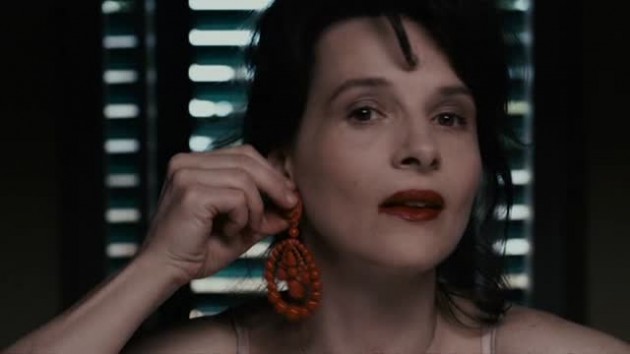
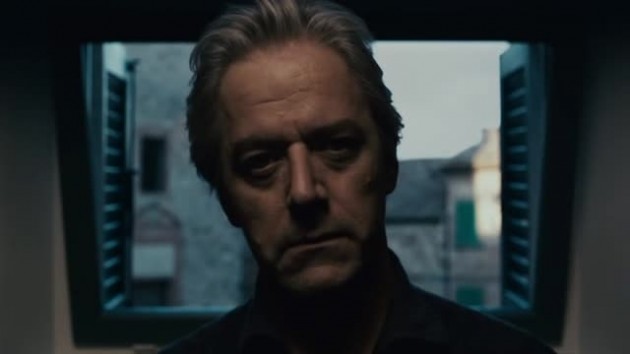
But how can that be since they are from two different locations, the first a bathroom in a street level restaurant, the second a bathroom in a second floor hotel room? The sound during the first shot was lively accordion music from a wedding party. In this final shot the sound is church bells and chirping birds, both being sets of sounds that one can associate with a wedding. Both shots end with the characters exiting screen left, leaving us to ponder and empty frame. These two shots, like most everything in the film, including the many allusions and references to other great, mainly romance films, are ‘copies’ of each other: not identical, but very similar. These two “false” mirror shots become a huit clos of rhyming emotions which mirror each other into cinematic infinity. 4
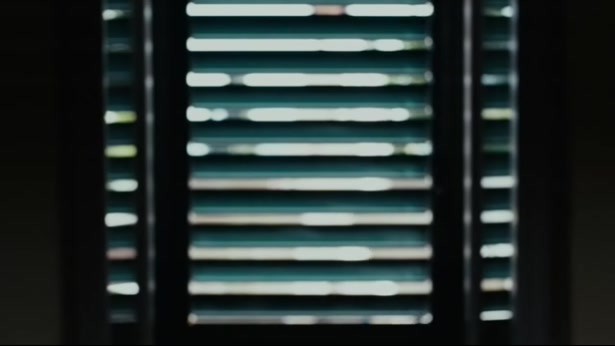
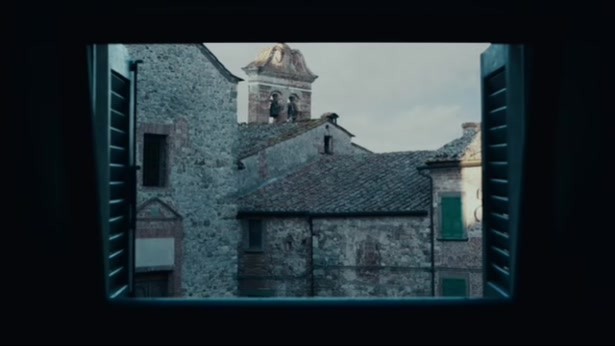
Notes
- “Reflexivity in Recent Iranian Cinema: The Case of Mohsen Makhmalbaf,” Asian Cinema Vol. 11, No. 2 (Fall/Winter 2000): 32-46. ↩
- This metaphor has its origin in a parable quoted by Makhmalbaf, “There is a parable that the fact was a mirror in God’s hand but it broke. People picked up the broken pieces and each one saw his reflection in it, each thought that he had held the fact, that he alone knew the reality.” ↩
- Obviously, there must be another film I can not remember which is the one Kiarostami is probably alluding to in this scene. I doubt he has seen The Inkeepers! ↩
- To make another intertexual reference, these shots of a character staring into a camera that stands in for a narrative ‘mirror’ also recalls the same illusionistic device in Kiarostami’s The Wind Will Carry Us (1999) where the lead character, the city engineer Bezhad ‘shaves’ looking directly into the camera. ↩



